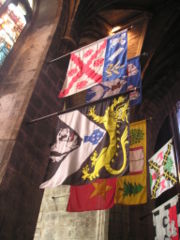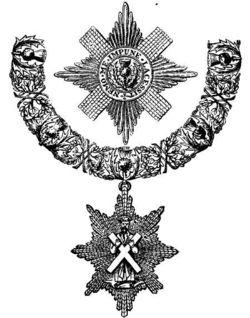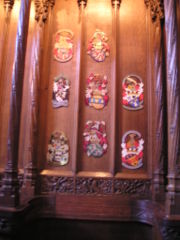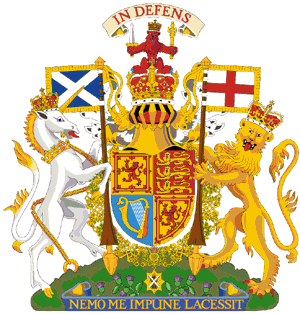Order of the Thistle
2007 Schools Wikipedia Selection. Related subjects: Military History and War
The Most Ancient and Most Noble Order of the Thistle is an order of chivalry associated with Scotland. While its original date of foundation is unknown, James VII (also King of England as James II) instituted the modern Order in 1687. The Order consists of the Sovereign and sixteen Knights and Ladies, as well as certain "extra" knights (members of the British Royal Family and foreign monarchs). The Sovereign alone grants membership of the Order; he or she is not advised by the Government, as occurs with most other Orders. The sixteen members are required to be Scottish-born, though not the "extra" knights and ladies.
The Order's primary emblem is the thistle, the national flower of Scotland. The motto is Nemo me impune lacessit (Latin for "No one provokes me with impunity"); the same motto also appears on the Royal Coat of Arms of the United Kingdom for use in Scotland and on some pound coins. The patron saint of the Order is St Andrew.
Most British orders of chivalry cover the entire kingdom, but the three most exalted ones each pertain to one constituent country only. The Order of the Thistle, which pertains to Scotland, is the second-most senior in precedence. Its equivalent in England, The Most Noble Order of the Garter, is the oldest documented order of chivalry in the United Kingdom, dating to the middle fourteenth century. In 1783 an Irish equivalent, The Most Illustrious Order of St Patrick, was founded; since the independence of the greater part of Ireland the Order has fallen dormant (its last surviving knight died in 1974).
History
The original date of the Order's foundation is unknown. According to legend, Óengus mac Fergusa (Angus), King of the Picts, while engaged in battle at Athelstaneford with the Saxon King Aethelstan of East Anglia, saw in the heavens the cross of St Andrew. After he won the battle, Angus is said to have established the Order of the Thistle, dedicating it to the saint, in 787. The tale is not credible, not only because of the unlikeliness of the alleged miracle, but also because the two individuals purported to have fought each other did not even reign during the same century. Another story states that Angus founded the Order in 809 to commemorate an alliance with the Emperor Charlemagne, which is a little less implausible given the Scottish bodyguards employed by Charlemagne. There is, in addition, a tradition that it was instituted, or re-instituted, on the battlefield by Robert I at Bannockburn. Many credit James III, who adopted the thistle as the royal plant badge and issued coins depicting thistles, with founding the Order during the fifteenth century. Others state that James V, who had been admitted to the Order of the Garter in England, the Order of St Michael in France and the Order of the Golden Fleece in the Holy Roman Empire, established the Order of the Thistle in 1540 because he was embarrassed that he had no honour to confer on foreign monarchs. He allegedly conferred membership of the "Order of the Burr or Thissil" on Francis I, King of France.
Some Scottish order of chivalry definitely existed during the sixteenth century, but had lapsed by its conclusion. James VII issued letters patent "reviving and restoring the Order of the Thistle to its full glory, lustre and magnificency" in 1687. Eight knights, out of a maximum of twelve, were appointed, but the King was deposed in 1688. His successors, the joint monarchs William and Mary, did not make any further appointments to the Order, which consequently fell into desuetude. In 1703, however, Anne once again revived the Order of the Thistle, which survives to this day.
Composition
The Kings of Scotland—later the Kings of Great Britain and of the United Kingdom—have served as Sovereigns of the Order. When James VII revived the Order, the statutes stated that the Order would "consist of the Sovereign and twelve Knights-Brethren in allusion to the Blessed Saviour and his Twelve Apostles." In 1827, George IV augmented the Order to sixteen members. Women (other than Queens regnant) were originally excluded from the Order; Elizabeth II, however, allowed the admission of Ladies of the Thistle in 1987.
From time to time, individuals may be admitted to the Order by special statutes. Such members are known as "Extra Knights" and do not count towards the sixteen-member limit. Members of the British Royal Family are normally admitted through this procedure; the first to be so admitted was a younger son of George III, HRH The Prince William Henry (later William IV). Olav V, King of Norway, the first foreigner to be admitted to the Order, was also admitted by special statute in 1962.
The Sovereign has historically had the power to choose Knights and Ladies of the Order. From the eighteenth century onwards, the Sovereign made his or her choices upon the advice of the Government. George VI felt that the Orders of the Garter and the Thistle had been used only for political patronage, rather than to reward actual merit. Therefore, with the agreement of the Prime Minister ( Clement Attlee) and the Leader of the Opposition (Winston Churchill) in 1946, the Order of the Thistle returned to the personal gift of the Sovereign.
Knights and Ladies of the Thistle may also be admitted to the Order of the Garter. Formerly, many, but not all, Knights elevated to the senior Order would resign from the Order of the Thistle. The first to resign from the Order of the Thistle was John Campbell, 2nd Duke of Argyll in 1710; the last to take such an action was Thomas Dundas, 2nd Earl of Zetland in 1872. Knights and Ladies of the Thistle may also be deprived of their knighthoods. The only individual to have suffered such a fate was John Erskine, 6th Earl of Mar who lost both the knighthood and the earldom after participating in the Jacobite rising of 1715.
The Order has five officers: the Dean, the Chancellor, the Usher, the King of Arms and the Secretary. The Dean is normally a cleric of the Church of Scotland. The Chancellor is normally one of the knights, though not necessarily the most senior. The Usher of the Order is the Gentleman Usher of the Green Rod (unlike his Garter equivalent, the Gentleman Usher of the Black Rod, he does not have another function assisting the House of Lords). The King of Arms of the Order, responsible for heraldry, is the Lord Lyon King of Arms, the head of Scottish Heraldry. The Lord Lyon often—but not invariably—also serves as the Secretary.
Vestments and accoutrements
For the Order's great occasions, such as its annual service each June or July, as well for coronations, the Knights and Ladies wear an elaborate costume:
- The mantle is a green robe worn over their suits or military uniforms. The mantle is lined with white taffeta; it is tied with green and gold tassels. On the left shoulder of the mantle, the star of the Order (see below) is depicted.
- The hat is made of black velvet and is plumed with white osprey feathers.
- The collar is made of gold and depicts thistles and sprigs of rue. It is worn over the mantle.
- The St Andrew, also called the badge-appendant, is worn suspended from the collar. It comprises a gold enamelled depiction of St Andrew, wearing a green gown and purple coat, holding a white saltire. Gold rays are shown emanating from St Andrew's head.
Aside from these special occasions, however, much simpler insignia are used whenever a member of the Order attends an event at which decorations are worn.
- The star of the Order consists of a silver St Andrew's saltire, with clusters of rays between the arms thereof. In the centre is depicted a green circle bearing the motto of the Order in gold majuscules; within the circle, there is depicted a thistle on a gold field. It is worn pinned to the left breast. (Since the Order of the Thistle is the second-most senior chivalric order in the UK, a member will wear its star above that of other orders to which he or she belongs, except that of the Order of the Garter; up to four orders' stars may be worn.)
- The broad riband is a dark green sash worn across the body, from the left shoulder to the right hip.
- At the right hip of the Riband, the badge of the Order is attached. On the obverse, the badge depicts St Andrew in the same form as the star. On the reverse, it depicts a thistle, on a green ground and surrounded by the Order's motto.
However, on certain "collar days" designated by the Sovereign, members attending formal events may wear the Order's collar over their military uniform, formal wear, or other costume. They will then substitute the broad riband of another order to which they belong (if any), since the Order of the Thistle is represented by the collar.
Upon the death of a Knight or Lady, the insignia must be returned to the Central Chancery of the Orders of Knighthood. The badge and star are returned personally to the Sovereign by the nearest relative of the deceased.
Officers of the Order also wear green robes. The Gentleman Usher of the Green Rod also bears, as the title of his office suggests, a green rod. Lord Lyon wears a tabard depicting the Royal Arms.
Chapel
When James VII revived the Order in 1687, he directed that the Abbey Church at the Palace of Holyroodhouse be converted to a Chapel for the Order of the Thistle, perhaps copying the idea from the Order of the Garter (whose chapel is located in Windsor Castle). James VII, however, was deposed by 1688; the Chapel, meanwhile, had been destroyed during riots. The Order did not have a Chapel until 1911, when one was added onto St Giles High Kirk in Edinburgh. Each year, the Sovereign resides at the Palace of Holyroodhouse for a week in June or July; during the visit, a service for the Order is held. Any new Knights or Ladies are installed at annual services.
Each member of the Order, including the Sovereign, is allotted a stall in the choir of the Chapel, above which his or her heraldic devices are displayed. Perched on the pinnacle of a knight's stall is his helm, decorated with a mantling and topped by his crest. Under the laws of heraldry, women other than monarchs do not bear helms or crests; instead, the coronet appropriate to the Lady's rank is used (see coronet). Unlike other British Orders, the armorial banners of Knights and Ladies of the Thistle are not hung in the chapel, but instead in an adjacent part of St Giles High Kirk. The Thistle Chapel does, however, bear the arms of members living and deceased on stall plates. These pieces of brass are affixed to the back of the stall and display its occupant's name, arms, and date of admission into the Order.
Upon the death of a Knight, helm, mantling, crest (or coronet or crown) and sword are taken down. The stall plates, however, are not removed; rather, they remain permanently affixed somewhere about the stall, so that the stalls of the chapel are festooned with a colourful record of the Order's Knights (and now Ladies) since 1911.
Precedence and privileges
Knights and Ladies of the Thistle are assigned positions in the order of precedence, ranking above all others of knightly rank, and above baronets. Wives, sons, daughters and daughters-in-law of Knights of the Thistle also feature on the order of precedence; relatives of Ladies of the Thistle, however, are not assigned any special precedence. (Generally, individuals can derive precedence from their fathers or husbands, but not from their mothers or wives.) (See order of precedence in Scotland for the exact positions.)
Knights of the Thistle prefix "Sir," and Ladies prefix "Lady," to their forenames. Wives of Knights may prefix "Lady" to their surnames, but no equivalent privilege exists for husbands of Ladies. Such forms are not used by peers and princes, except when the names of the former are written out in their fullest forms.
Knights and Ladies use the post-nominal letters "KT" and "LT," respectively. When an individual is entitled to use multiple post-nominal letters, "KT" or "LT" appears before all others, except "Bt" or "Btss" ( Baronet or Baronetess), "VC" (Victoria Cross), "GC" ( George Cross) and "KG" or "LG" (Knight or Lady of the Garter).
Knights and Ladies may encircle their arms with the circlet (a green circle bearing the Order's motto) and the collar of the Order; the former is shown either outside or on top of the latter. The badge is depicted suspended from the collar. The Royal Arms depict the circlet, superimposed over the collar, of the Thistle only in Scotland; they show the Garter in England, Wales and Northern Ireland.
Knights and Ladies are also entitled to receive heraldic supporters. This high privilege is only shared by members of the Royal Family, peers, Knights and Ladies of the Garter, and Knights and Dames Grand Cross and Knights Grand Commanders of the junior orders.
Current members and officers
Sovereign
Knights and Ladies Companion
- The Right Honourable The Earl of Wemyss and March KT DL (1966)
- His Grace The Duke of Buccleuch and Queensberry KT VRD DL (1978)
- The Right Honourable The Earl of Elgin and Kincardine KT CD DL (1981)
- The Right Honourable The Lord Thomson of Monifieth KT PC DL (1981)
- The Right Honourable The Earl of Airlie KT GCVO PC (1985)
- The Right Honourable The Viscount of Arbuthnott KT CBE DSC (1996)
- The Right Honourable The Earl of Crawford and Balcarres KT GCVO PC (1996)
- Lady Marion Fraser LT (1996)
- The Right Honourable The Lord Macfarlane of Bearsden KT DL (1996)
- The Right Honourable The Lord Mackay of Clashfern KT PC (1997)
- The Right Honourable The Lord Wilson of Tillyorn KT GCMG (2000)
- The Right Honourable The Lord Sutherland of Houndwood KT (2002)
- Sir Eric Anderson KT (2002)
- The Right Honourable The Lord Steel of Aikwood KT KBE PC (2004)
- The Right Honourable The Lord Robertson of Port Ellen KT GCMG PC (2004)
There is one vacancy
Supernumerary Knights and Ladies
- HRH The Prince Philip, Duke of Edinburgh KG KT OM GBE AC QSO PC (1952)
- HRH The Prince Charles, Duke of Rothesay KG KT GCB OM AK QSO PC ADC (1977)
- HRH The Princess Royal LG LT GCVO QSO (2000)
Officers
- Dean: The Very Reverend Gilleasbuig Iain MacMillan CVO
- Chancellor: His Grace The Duke of Buccleuch and Queensberry KT VRD
- Usher: Rear Admiral Christopher Hope Layman CB DSO LVO (Gentleman Usher of the Green Rod)
- King of Arms and Secretary: Robin Orr Blair LVO WS ( Lord Lyon King of Arms)





